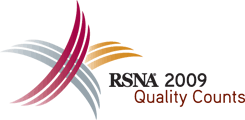
Abstract Archives of the RSNA, 2009
LL-IN2105-B04
Abbreviations in Radiology: Are They Safe?
Scientific Posters
Presented on November 29, 2009
Presented as part of LL-IN-B: Informatics
 Research and Education Foundation Support
Research and Education Foundation Support
Shilpi Pal MBChB, MSc, Presenter: Nothing to Disclose
Richard D. White MBChB, Abstract Co-Author: Nothing to Disclose
George D Watson MBCHB, Abstract Co-Author: Nothing to Disclose
Ian Alexander Zealley MD, Abstract Co-Author: Nothing to Disclose
Abbreviations have been shown to be a key factor in medication prescription errors. We analyze the role of abbreviations in radiology examination request cards and determine whether or not they can be safely used, hypothesizing that they are a potential source of medical errors in radiology
600 radiology requests were analyzed by two radiologists: 200 consecutive requests for each of US (ultrasound), CXR (chest x-ray) and CT (computed tomography). All abbreviated words and symbols (henceforth jointly referred to as “abbreviations”) and the total number of words and symbols per card were documented. For each abbreviation present in >1% of request cards per modality, a review group (2 radiologists, 2 sonographers and 2 radiographers) was asked to determine its meaning in isolation. If not apparent, original requests were shown to provide the clinical context. Results were recorded including the overall abbreviation and word counts in each modality
CT requests contained significantly more abbreviations (median 8, range 1-23) than either US (median 6, range 0-24) or CXR cards (median 5, range 1-19), P for difference <0.0001, Mann-Whitney U test. The total number of words per request was significantly greater for CT (median 28.5, range 7-71) than US (median 20, range 4-64) and for US than CXR (median 16, range 3-55). P for difference in each case <0.0001, Mann-Whitney U test.
The number of different abbreviations used in the US, CXR and CT requests was 134, 139 and 290 respectively, of which 20%, 22% and 20% occurred in >1% of requests. Most were immediately understood by the review group; 11% of US, 5% of CT and 13% of CXR abbreviations required the clinical context for correct interpretation. All intended meanings were evident when viewed in context
Abbreviations are common in radiology requests, especially in examinations such as CT which require greater referrer justification due to the increased radiation dose. Here, the use of abbreviations in radiology request cards appears to be a safe method of communication. Problems may arise when ambiguous abbreviations are used, and we advocate diligence on the part of the referring clinician to avoid confusion
Abbreviations are common in medicine, but have been shown to have negative implications for patient safety in drug prescribing. We analyze their use in radiology and ask the question: are they safe?
Pal, S,
White, R,
Watson, G,
Zealley, I,
Abbreviations in Radiology: Are They Safe?. Radiological Society of North America 2009 Scientific Assembly and Annual Meeting, November 29 - December 4, 2009 ,Chicago IL.
http://archive.rsna.org/2009/8005401.html
Accessed November 13, 2025


 Research and Education Foundation Support
Research and Education Foundation Support